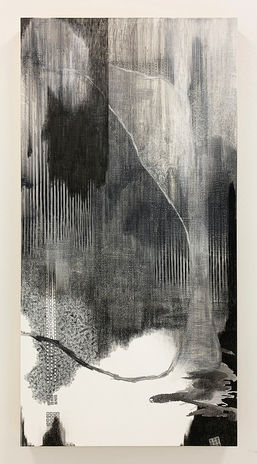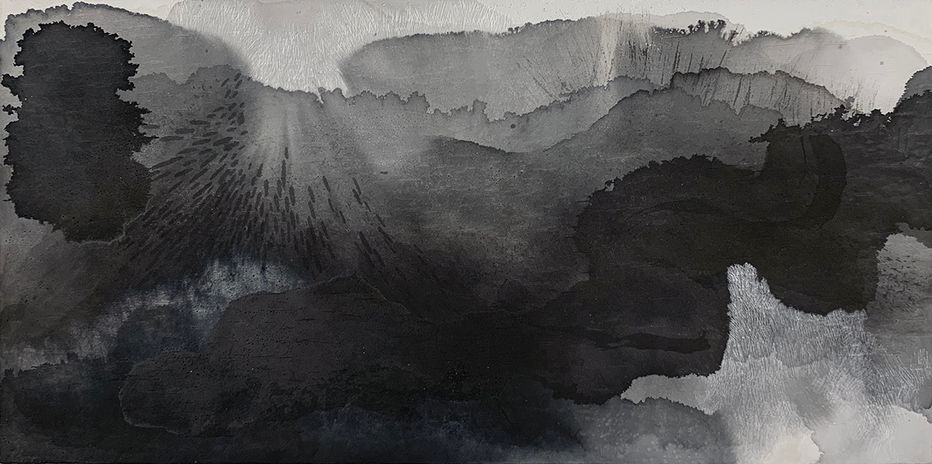
![KuroKuroShiro T+S III 72 2000[2]_edited.jpg](https://static.wixstatic.com/media/1a1d7e_a01c829ba6d244c3a291ea80834cd728~mv2.jpg/v1/crop/x_7,y_419,w_734,h_290/fill/w_712,h_281,al_c,q_80,usm_0.66_1.00_0.01,enc_avif,quality_auto/KuroKuroShiro%20T%2BS%20III%2072%202000%5B2%5D_edited.jpg)
Somewhere Around There
Nishiki Sugawara-Beda
In “Somewhere Around There,” at Amos Eno Gallery, NY, Nishiki Sugawara-Beda presents a group of sumi ink works on wood panel, taken from her series “KuroKuroShiro” (BlackBlackWhite). Sugawara-Beda is originally from Japan, and currently lives and works in Dallas, where she teaches at Southern Methodist University. Sugawara-Beda’s work is often close to the tradition of Zen painting, but also is influenced by the American abstract tradition. When we see semi-hybrid works like these, it becomes clear that America remains a home for eclectic experimentation, so that an artist like Sugawara-Beda can find herself in a mixed esthetic.
In the work “KuroKuroShiro T+S III” (2022), the vertically aligned painting is an amalgam of black-and-white effects: striations, black patches over the striations, areas of white, and a drooping, curved line toward the bottom of the composition. The varied visual touches create an atmosphere almost textural in nature, even though this is a very flatform work of art. This piece feels more Western than Asian; its abstraction is rather like a patchwork of outcomes that have taken place by chance. Fine art is almost always a matter of chance, made coherent by craft and even reason. The work demonstrates both feeling and rational motive. In contrast the painting, “KuroKuroShiro VII” (2021) feels much more Japanese. The work consists of overlapping layers of black that look a lot like clouds without light, it is most dense on the lower half, and lighter on the top, eventually making its way to a near white at the highest part of the composition. The sumi painting might be a cloudscape or a generalized landscape, but it is also pure abstraction. When Sugawara-Beda’s work hovers between something recognizable and something not, its theme is one of both tonalities of tint and subtle implications of readable form—although what the form is, we are not quite sure.
The work entitled “KuroKuroShiro The A” (2022) is essentially a line drawing consisting of horizontal lines across the top and middle of the composition, with angled lines between them. A black mass occurs on the top right, with a horizontal emanating from its bottom, along the middle of the plane. Some smaller masses occur at the bottom of the wood panel, with filled and hollow stripes going across the bottom right. When we see a mixture of reactions such as these occurring in Sugawara-Beda’s paintings, we notice how fluent Sugawara-Beda is at bridging the gap between her roots and the culture she is embracing. Sugawara-Beda manages to implicitly suggest that a new order can be made. Sugawara-Beda’s process can turn in one direction or the other; her skill is such that she feels entirely comfortable in using both Western abstraction with Eastern form in a way that resists recognition of thinking one way or the other.
- Jonathan Goodman, May 21, 2022
(images courtesy of the artist)


![Somewhere Around There Installation shot SL 2 75 1200[3]_edited.jpg](https://static.wixstatic.com/media/1a1d7e_e3d8197e360242dd89d97ea0f584cb67~mv2.jpg/v1/fit/w_696,h_464,q_90,enc_avif,quality_auto/1a1d7e_e3d8197e360242dd89d97ea0f584cb67~mv2.jpg)

![Somewhere Around There with name 72 2000[2]_edited.jpg](https://static.wixstatic.com/media/1a1d7e_5fb0d61aacbd4cbd904fcebc209234e3~mv2.jpg/v1/fit/w_825,h_464,q_90,enc_avif,quality_auto/1a1d7e_5fb0d61aacbd4cbd904fcebc209234e3~mv2.jpg)
![KuroKuroShiro T+S and D 72 2000[2]_edited.jpg](https://static.wixstatic.com/media/1a1d7e_9c2286b44da0455d8c58f742fc0b69c4~mv2.jpg/v1/fit/w_825,h_464,q_90,enc_avif,quality_auto/1a1d7e_9c2286b44da0455d8c58f742fc0b69c4~mv2.jpg)
